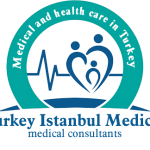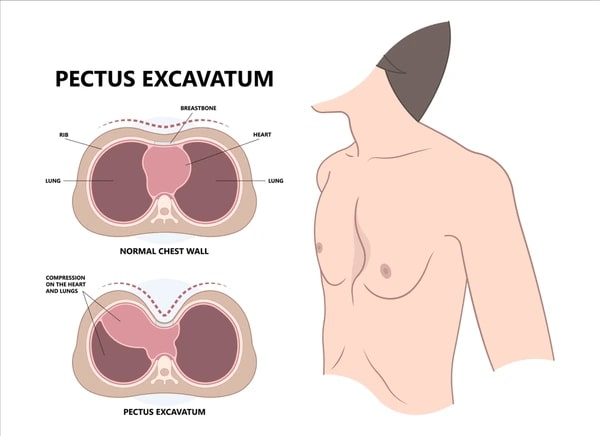What is Shoemaker’s Breast (Pectus Excavatum) ?
Deformities in the breast wall may occur due to some abnormalities in the musculoskeletal system or simply due to the development of the rib cage differently than it should normally be. According to research, pectus excavatum, or shoemaker’s breast, constitutes approximately 88-90% of breast deformities. Shoemaker’s breast is a health problem characterized by the collapse of the sternum, that is, the breastbone, into the rib cage.
According to a study conducted in 2016, shoemaker’s breast is the most common sternum deformity in children. Additionally, the same research shows genetic factors as the primary cause of shoemaker’s breast. Some studies show that the ribs grow larger than they should be as the cause of sternum deformities.
Shoemaker’s breast is usually noticed in childhood. However, in some cases, it is possible to notice shoemaker’s breast during adolescence. Rib overgrowth can push the rib cage inward or outward.
What are The Causes of Shoemaker’s Breast (Pectus Excavatum)?
Shoemaker’s Breast & Pigeon’s Breast are colloquial terms used to describe certain breast wall deformities.The specific causes of these conditions are not fully understood, but they are generally believed to be caused by a combination of genetic and environmental factors:
-
Genetic Predisposition:
Pectus carinatum may have a genetic component, as it sometimes runs in families.
-
Connective Tissue Abnormalities:
Pectus carinatum has been associated with some connective tissue disorders, such as Marfan syndrome or Ehlers-Danlos syndrome.
These conditions affect the strength and flexibility of connective tissues throughout the body, potentially contributing to breast wall deformity.
-
Growth Imbalance:
During the period of rapid growth during adolescence, an imbalance in the growth of the ribs, sternum and surrounding cartilages can occur, causing the sternum to protrude.
What are The Symptoms of Shoemaker’s Breast (Pectus Excavatum)?
Shoemaker’s breast can make it difficult for the lungs and heart to work due to the shape of the faith board. Symptoms can occur both physically and psychologically.
Physical Symptoms
- Difficulty breathing during exercise
- Lack of strength compared to peers
- Tiredness
- Breast pain
- Irregular heartbeat
Psychological Symptoms
- Feeling ashamed of the appearance of the breast
- Decreased self-esteem
- Depression
How to Diagnose Shoemaker’s Breast (Pectus Excavatum)?
Most of the time, a diagnosis of shoemaker’s breast can be made through a physical examination performed by a specialist doctor.
Additionally, in the diagnosis of shoemaker’s breast;
- CT (Computed Tomography),
- MRI (Magnetic Resonance)
Imaging techniques such as can also be used.
Collapse of the sternum can cause heart and lung problems such as respiratory failure and cardiac arrhythmia.
For this reason, the specialist doctor may request some tests to evaluate whether the patient has a problem with the heart and lungs.
What are The Treatment Methods for Shoemaker’s Breast (Pectus Excavatum)?
-
Surgical Treatment
Surgical intervention aims to correct the breast deformity and improve the patient’s cardiac and respiratory functions. The ideal age range for surgical correction of shoemaker’s breast is 7-14. It is important that the surgery be performed before adolescence, as the rib cage can take its normal shape more easily during the period of rapid growth.
-
Modified Ravitch Surgery
Modified Ravitch Surgery is a traditional open surgery type that has been used for many years in the treatment of shoemaker’s breast.
This method is the process of removing the cartilaginous part of the ribs that causes the breast to be pushed back, by entering through a relatively long incision on the front of the rib cage. In this way, the faith board is pulled away from the heart and lungs and towards the normal plane of the breast wall.
-
Nuss Surgery
American surgeon Dr. This technique, developed by Donald Nuss, is the most current treatment used today. Nuss surgery is a closed surgery performed using minimally invasive methods.
The process of the surgery works as follows:
- If the patient is a smoker, he is asked to stop smoking at least two months before the surgery.
- General anesthesia is applied during the surgery.
- To eliminate the resulting collapse, a curved steel rod called “bar”, specially prepared according to the patient’s measurements, is used.
- Small incisions of two centimeters are made on both sides of the breast.
- The prepared bar is inserted under the faith board through both holes and the curve of the bar is reversed with the help of special rotating tools to remove the depression.
- The placed bar is fixed by sewing it to the muscle tissue with non-dissolving threads in the incision areas.
- Depending on the patient’s needs, 2 or rarely 3 bars can be used.
- The duration of the surgery takes approximately 45-60 minutes.
Home Care After Ravitch or Nuss Surgery
Patients who undergo the Ravitch procedure without breast support are seen only as needed after the first postoperative follow-up appointment. Patients who undergo a Ravitch or Nuss procedure with breast support are called for a follow-up appointment once a year after the first visit. The support or rod will usually remain in place for 2-3 years.
- You can take a shower 5 days after the surgery.
- There are no stitches to be removed. The popping stitches are under the skin and can dissolve on their own.
- Narcotic pain treatment may be required for up to one month after surgery.
- Constipation is a common problem and daily use of laxatives is recommended when using narcotics.
- Redness or swelling at the incision(s) should be reported as soon as it is noticed.
- If the person is discharged with a drain, the drain will be removed in the hospital when the drainage stops.
- Children with pectus bar should call the hospital in case of any trauma to the breast, pain in the arms, numbness, or pain that does not relieve with oral medications.
- The person can start exercising as soon as the surgeon decides it is safe to do so. Some contact sports may not be permitted while the bar is in place.
- MRI should not be performed while the pectus bar is in place.
- Physical therapy may be helpful in improving posture.
- It is always recommended to use a medical alert bracelet or necklace to alert doctors to the presence of a Pectus rod in emergency situations.

